About shooting accuracy in the battle of Jutland (part of 2)
Having considered the accuracy of firing of the linear cruisers of both opponents, we proceed to the battleships. Unfortunately, the information in the sources about the dreadnoughts of the Grand Fleet and Hochzeeflotte is much less detailed and does not allow for an analysis in the context of each ship. Nevertheless, some conclusions can be obtained from the available data.
After examining the descriptions of hits in every single ship of the British, we get the following (the table shows the names of British ships and hits in them from German battleships and battle cruisers)
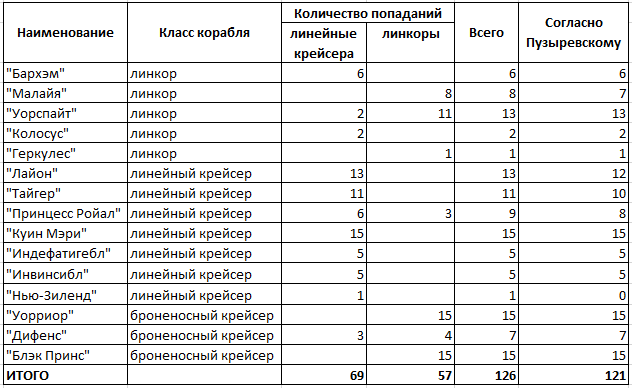
According to the data presented in it, the number of hits on British ships is slightly higher than the generally accepted (according to Puzyrevsky) values. This is due to the fact that, according to Muzhenikov’s detailed descriptions, Malaya, Lyon, Tiger and Princess Royal fell on one projectile more than indicated by Puzyrevsky, and besides, the latter did not take into account “ New Zealand ”with“ Fon der Tanna ”. In accordance with the above, the British ships did not hit 121, but 126 large-caliber projectiles, including 69 from the battlecruisers (assuming that there were 15 hits in Queen Mary) and 57 from the ships of the line.
Given that the German dreadnoughts in the battle of Jutland spent 1 904 projectile, 57 hits give 2,99% of the total number of projectiles, but you should consider one very important nuance. The fact is that from the 57 15 hits recorded accounted for the armored cruiser "Black Prince", and that's what happened to him story.
With the onset of darkness, the armored cruiser seems to have lost its way and, going separately from the rest fleet, stumbled upon a dreadnought column of the High Seas Fleet. Probably, the cruiser thought they saw their ships, otherwise there is no way to explain why the Black Prince, discovered by Thuringen and Ostfriesland, at a distance of less than a mile (only 8 kb) continued to draw closer to the Germans. Several German ships hit him on a saz. It was not possible to establish the exact number of battleships firing on Black Prince, since the sources contradict each other, but all agree on one thing: the armored cruiser was shot from some 5,5 cable ones, i.e. just over a kilometer. At such a distance, the heavy guns of the dreadnoughts of the Hochzeflotte could fall on direct fire.
"Black Prince", in fact, was substituted by a blow, allowing the Germans to "increase the score" with a minimum expenditure of shells. The fire on the doomed armored cruiser, most likely, turned out to be extremely effective, because it was carried out almost at close range. Of course, such shooting cannot serve as confirmation of the high professionalism of the German artillerymen, and for comparison with the achievements of their British colleagues, the execution of the Black Prince should be excluded.
The only problem is that we do not know the number of shells spent on the British armored cruiser. It is likely that the target hit every second or third round, and maybe the Germans fired even better. But even if we assume that only every tenth projectile hit (that is, when shooting at Black Prince, the percentage of hits was only 10%), then in this case the 15 hits accounted for 150 hits. Accordingly, in all other episodes of the battle, the German dreadnoughts spent 1 754 projectile and achieved 42 hits, which gives a very moderate 2,39%, but in fact, most likely, this percentage is even lower.
Thus, the accuracy of the shooting of the German linear fleet is absolutely not amazing. Dreadnoughts shot out at 1,75 times worse than Rear-Admiral Hipper's battlecruisers (according to them, the accuracy of 4,19% seems to be the most likely). Perhaps this is due to much worse conditions in which the battleships had to fight. With the exception of shooting at the 5 squadron of Evan-Thomas battleships, in all other cases the British had an advantage in appearance and on the German dreadnoughts they very poorly distinguished the enemy. Both the first and the second fights of the German and British dreadnoughts were characterized by the fact that not even British ships saw the German ships, but flashes of their shots.
As for the British battleships, a slightly more detailed analyst is possible for them solely due to the large difference in the caliber of the guns. Despite the fact that the German 305-mm projectile was about a quarter heavier than the 280-mm, yet it is not so easy to distinguish between their hits. Another thing - the British 305-mm, 343-mm and 381-mm projectiles, which hit "diagnosed" much better. Accordingly, we have the opportunity to determine the accuracy of firing of the superhigh-winds in the context of their calibers, i.e. on ships carrying 381-mm, 343-mm and 305-mm separately.
As in the case of the German results of shooting, the analysis according to Muzhenikov gives a slightly better picture than Puzyrevsky shows, but the discrepancies are even greater. According to Puzyrevsky, “Helgoland” and “Nassau” got one hit each, the Husbands confirming none. The author of this article in this case holds the position of Muzhenikov. In the case of Helgoland, simply because the Muzhenikov monographs are more detailed and detailed and therefore look more trustworthy. In the case of the Nassau, it can be assumed that Puzyrevsky mistakenly counted the damage to the German dreadnought, which he received as a result of a collision with the British destroyer Spitfire, as damage from hitting an English heavy projectile.
Here is how Mujen described the aftermath of a collision between Nassau and Spitfire:
And this is how the Husband's damage is described:
Since the fact of a collision between Nassau and Spitfire is indisputable, and given the fact that Puzyrevsky does not mention a collision when describing damage to Nassau, we can assume that in this case, it is Muzheniki who is right.
Absolutely contradictory data on hits in the "Kaiser". As we said before, foreign sources contradict each other, but Campbell and Brayer still claim that there were two hits, and Campbell attributed them to the 4 phase of the battle, when Commander Hohzeeflotte Scheer framed his battle lines under the blow of the British line a second time. Campbell even points out the caliber of the shells that hit the Kaiser battleship - 305-mm. But Hildebrand testifies that the Kaiser in the battle of Jutland did not receive any damage. Puzyrevsky finally confuses the affair, claiming that the Kaiser received one hit of an 343-mm projectile from Marlboro battleships, while the second projectile of the same caliber did not hit the ship, but exploded nearby and caused only fragmentary damage.
Since most of the sources are inclined to two hits, and Campbell is probably still more reliable than Puzyrevsky, we will read the English two hits to the Kaiser in 305-mm caliber.
Puzyrevsky indicates a hit into the Schleswig-Holstein dodrednaught, the Husbands — into Pommern, but, by and large, if this hit really happened, then for our calculations it is not too important which particular battleship hit the shell.
In the information about the British hits in the battlecruisers of the Germans, there are also large and unexplained discrepancies. The most simple situation with “Derflinger” - Puzyrevsky reports 17 hits with a large caliber, but Muzhenik gives detailed descriptions of 21 hits, and therefore we accept the Muzhenikov data.
Puzyrevsky notes 4 falling into the “Fon der Tann”, while the Mujenics writes about five, noting, however, that one of them is unidentified (that is, the projectile was heavy, but of unclear caliber). As we have previously suggested, it could be a shell from New Zealand. We put 5 hits.
According to "Seidlitsu" the situation is very controversial, because again there are discrepancies in foreign sources - either 22 or 24 hits, but since, quoting Hildebrand and Brayer, Husband mentions only 22 hits, we’ll dwell on the 22 digit.
The situation with the “Moltke” is also difficult, because the same projectile (343-mm from “Tiger”) in one case is treated as a hit, in the other - as a close gap. The author of this article counted him as a hit. But it should be understood that this is an author's arbitrariness in its pure form, since the decision was made for reasons of the following nature: “Since 2 has already removed all possible hits to Seidlits, then let’s take that one hit into Moltke”. Alas, for a reliable picture it is necessary to work well with the original sources in the British and German archives, and the author, unfortunately, is deprived of this opportunity.
Questions remain on hitting the German cruisers Pillau and Wiesbaden, and since the latter died, no archive will provide reliable information on it. The descriptions of the Battle of Jutland speak of several hits of heavy shells in these cruisers, and most likely this is exactly what happened, but still 4 read hits (three in Wiesbaden and one in Pillau) again is copyright arbitrariness. However, this assumption will in no way affect the assessment of the accuracy of the shooting of the British dreadnoughts, because the 3-I squadron of battle cruisers fired at these German ships
In view of the above, it can be assumed that the total number of hits in German ships is also slightly higher than the generally accepted one - 107 hits, not 101, while the British battlecruisers achieved 38 hits, battleships - 69. British battleships spent 2 578 shells, respectively, the average percentage of hits was 2,68%. Thus, it can be argued that, in general, the British battleships in Jutland fired better than the German ones.
At the same time, the best results were shown by superdreadnoughts carrying 343-mm guns. Interestingly, only Marlboro (162 projectile) and Iron Duke (90 projectiles) Orion, Monarch and Conqueror fired for some lengthy firing and spent 51, 53 and 57 projectiles, Benbow respectively and Tanderer - 40 and 37 shells, and the rest barely had time to open fire: Centurion, King George V, and Ajax fired 19, 9 and 6 shells, respectively. Total battleships spent 524 projectile and achieved while 18 hits, the percentage of which reached 3,44%
Dreadnoughts with 381-mm guns are in second place. In total, the British spent 1 179 shells of this caliber, and the Germans recited 37 hits with these shells, which gives the percentage of hits 3,14% As you know, four such ships (Barham, Malaya, Worspite and Valiant) were The 5 squadron of battleships operating jointly with the Beatty battlecruisers while the other two (Rivendge and Royal Oak) fought alongside Jellico's battleships. Mujenikov writes that "Rivendzh" achieved three hits in "Derflinger", and "Royal Oak" - two in "Derflinger" and one in "Seidlits", while most likely there were no hits to other battlecruisers from these battleships, be hit by dreadnoughts hohzeeflott. Therefore, to assess the accuracy of shooting 5-th battleship squadron, unfortunately, is not possible.
In the very tail, the 305-mm battleships of the British fleet “trail”. Having spent the 833 projectile, they achieved all 14 hits, which is 1,68%.
Well, time to take stock.
In total, the Germans used up 3 549 shells in the Battle of Jutland and achieved 126 hits, the percentage of which was 3,55%. But with the exclusion of the results of "Black Prince", we get approximately 3 399 shells, 111 hits and 3,27%. The British spent 4 420 shells, achieving 107 hits, which gives the percentage of hits equal to 2,42%.
Thus, it can be stated that the ratio of shooting accuracy (2,42% -3,27%) is slightly better for the British than the generally accepted figures (2,2% -3,4%), although, of course, the percentage of German hits is higher. As for the rating of connections and individual ships, it should be understood that it is sufficiently conditional, if only because of possible errors in determining the ships that achieved hits.
You should also understand that such a rating only indirectly characterizes the skills of gunners, because a high percentage of hits of one compound can be achieved in conditions of good visibility and at short distances, while a different compound that showed the worst result led the battle in much more difficult conditions. .
When reviewing the performance of individual groups of ships, the author often operated with several values of hit percentages, due to the misinterpretation of projectile consumption in sources or due to an undetectable number of hits (to dead ships), but for the rating, the author accepts single values - those that seem most likely to him.
The British 3 squadron of battlecruisers - 4,56% demonstrated the best accuracy indicators in the battle of Yutland.
In second place is the battle cruiser 1 of the admiral Hipper's reconnaissance group - 4,19%.
The third place is occupied by the British "343-mm" superdreadnoughts - 3,44%.
The fourth place in the “381-mm” super-dreadnoughts of the British is 3,14%.
The fifth place is received by the battleships of Germany - 2,39%.
The sixth place in the British 1-nd squadron of battle cruisers (343-mm) - 1,78%.
Seventh place was taken by the British "305-mm" battleships - 1,68%.
And, finally, the British 2 Squadron of the battle cruisers (305-mm) - 0,91% turns out to be the first from the end.
As for the "individual offset", then it wins ... British ships.
The first place by a large margin is taken by Royal Oak. According to the descriptions, he achieved two hits in “Derflinger” and one - in “Seidlits”, despite the fact that during the whole battle he spent only 38 shells, which gives a completely enchanting percentage of hits - 7,89%!
The second place, apparently, belongs to the “305-mm” British dreadnought “Kolosus”. Having spent the 93 projectile, the battleship achieved five hits in “Derflinger”, which is 5,38%
In third place is the flagship Hipper "Lutzov" - 380 spent shells and 19 hits, 5%.
However, there is another ship that has the opportunity to qualify for inclusion in the top three, this is the Derflinger. It is believed that this battlecruiser spent 385 shells, having achieved 16 hits. But only 3 hits at Queen Mary are “recorded” on it, which is extremely doubtful, and if in fact he achieved 6-7 hits on this British ship, then the percentage of hits of the Derflinger will increase to 4,94-5,19%.
Nevertheless, I would like to once again note the extreme conventionality of this rating and recall that other ships that were not included in the rating showed even better accuracy in certain moments of the battle. For example, “Fon der Tann” achieved five hits in “Indefatigeble” and destroyed it, having spent only 52 of the projectile, that is, in this period of the battle its percentage of hits was 9,62%! But later the ship had to go zigzagging in an attempt to avoid being hit by fifteen-inch British shells that were deadly for him. In addition, combat damage led to the inability to shoot from part of the main-caliber towers (there was a period when all eight 280-mm guns did not work) and all this could not affect the further accuracy of the Fon der Tanna.
Generally speaking, the shooting accuracy is influenced by many reasons, of which, besides the artillery training level, the following can be distinguished: the presence of centralized fire control, the quantity and quality of rangefinders, the quality of fire control systems, the quality of projectiles and guns, the distances being fired, lighting and visibility. The damage inflicted on the shooting ship is very important: high-quality shooting is achieved with the participation of at least four barrels in the salvo, and the highest speed of shooting is in the presence of eight, ten or twelve barrels. For example, Derflinger fired four-gun half-salts, while the four guns fired a volley, the rest reloaded. Accordingly, it is in no way possible to demand the same accuracy from “Derflinger” at the beginning of the battle, when he was fully operational and near the end, when two of his four towers were silenced.
Or, for example, range finders. It is known that the optical range finder is a very difficult to handle device that requires the operator, in addition to work skills, to have perfect vision in both eyes. There were seven range finders on the “Derflinger”, and they worked with them like this: they made measurements to the enemy, all seven, and then chose the average value, discarding the extreme options. However, during the battle rangefinders failed, and the measurement accuracy, of course, fell.
Or, for example, such a seemingly “smallness” as ... mud. The Germans, apparently, very carefully studied the experience of the Russian-Japanese war, including the massive death of the commanding staff of the Russians due to the poor design of armored military logging: large viewing slots, unsuccessful roof construction ... In Germany, the question was solved radically - in battle special “armored artillery shutters” were raised, which turned the conning tower into a hermetically sealed room. Observation at the same time was carried out by means of devices similar in construction to the periscope and stereo tube. This was, without any doubt, a reasonable and ingenious decision, however, as the senior gunner of the Derflinger, Georg Haase, writes:
Thus, the shooting accuracy is influenced by many different factors and almost never happens so that both sides in battle have equal conditions for shooting at their opponent. But it would be extremely difficult to analyze them in all their diversity, so that we confine ourselves to a brief description of the conditions in which the German and British gunners fought.
It is well known that in the first phase of the battle (from the moment it began in 15.48 until the turn of the Evan-Thomas battleships from dreadnoughts Hohzeeflott in 16.54) the lighting was not on the British side. Their ships were on the background of the bright part of the horizon, the Germans - against the background of darkness, and this, of course, could not but affect the results of the fire fight. However, according to Campbell in this period, 44 shells hit British ships, while German ones received just 17, and this ratio can hardly be explained solely by the difference in illumination. Usually, the superiority of German rangefinders over British ones is also indicated, and this is certainly true. But here it is necessary to take into account this. The range finder is a very important, but far from the only component of the fire control system. In those years, analog computers (AVMs) were used for this purpose, which made it possible, on the basis of the data on the course, speed, range, and other data of the own ship and the target ship, to calculate the magnitude of the change in distance and target pickup angles. But if something is known about the British AVMs, there is very little data about the German SLAs, while there is sufficiently authoritative evidence (the British historian Wilson, who in turn refers to the story of the senior artilleryman "Luttsov" Paschen, published in the journal "Marin Rundschau" ), that the FCS of Germany still lost as a British one.
It should also be taken into account that, if the Beatty battlecruisers were equipped with “9-foot” rangefinders, which were really inferior to the German ones, the Barharmus, “Valiant”, Worspite and Malaya superdreadnoughts had much more advanced “16-feet” range finders (the so-called “base” is measured in feet, the bigger it is, the more accurate the range finder) and it is unlikely that they lost so much on German optics. Presumably, the material part of the “381-mm” super dreadnoughts was not inferior to that of the German battle cruisers, which means, all other things being equal, one would expect equivalent results of shooting.
But the conditions were not equal - firstly, the lighting "played" against the British, and secondly, the commanders of the terminal German cruisers ("Moltke" and "Fon der Tann"), knowing full well what their long-term shelling of fifteen-inch shells threatened their ships from zigzag, knocking the tip of the British gunners. Of course, in this case, the accuracy of the fire of these battlecruisers should have decreased, but this is exactly what we observe - Moltke shot out almost worse than all other Hipper ships, and the accuracy of Fon der Tanna after the sinking of Indefatigeble dropped sharply. But, again, it cannot be argued that the only reason for this was their “zigzags”.
It is interesting to evaluate the results of the shooting of the leaders of our rating, the ships 3-she squadron of battlecruisers. The fact is that the bulk of their hits was made from a distance of 50 KB and lower. So, “Wiesbaden” and “Pillau” were fired with 49 KBT, the battle with Hipper battlecruisers also began around 50 KBT, after which the distance was reduced. This is significantly less than the distances at which the Hipper and Beatty battlecruis fought, but does this indicate that the 3-I squadron of the battlecruisers fought in certain "greenhouse" conditions compared to the latter?
It should be taken into account that in order to correct artillery fire it is extremely important to correctly determine the target parameters (course / speed / distance) and, subsequently, to observe the fall of your own shells. Of course, it is easier to do this in the vicinity than in the distance, but not only distance, but visibility, is important here. In other words, if, say, the visibility is ten miles, then the ship is shot at a target seven miles from it, better than a target located five miles with a visibility of five miles. Because in the first case, the gunners will shoot at a perfectly visible target, while in the second they will hardly distinguish it, although it is closer. As the commander of the battle cruiser Lion, Chetfield, later admiral said:
So, 3-I squadron of battle cruisers just fought in conditions where visibility ranged from 4 to 7 miles, depending on the specific location and direction. And the shelling of the German light cruisers, and the beginning of the battle with the ships of the Hipper took place at the moment of the enemy's discovery, that is, at the range limit. Therefore, we have no reason to believe that Horace Hud’s ships would have shot worse than German battlecruisers at long distances - well, unless it’s because of 9-foot rangefinders inferior to German optics and ... perhaps because of poor-quality 305 hardware -mm guns, but we'll talk about this a little later.
As for the relatively poor-quality shooting of the German dreadnoughts, there is a very simple explanation for this, and this is due to the fact that the Germans almost did not see the enemy in both cases of the collisions of the Scheer and Dreadnoughts battleships. If we analyze the statistics of hits, we will see that Sheer's dreadnoughts fell into the super-middotes of the 5 squadron, in Princess Royal, when it was within reach, but not in Jellico's battleships. In fact, only one single hit into the Hercules was noted, while the rest of the German dreadnoughts fell into the armored cruisers Warrior and Defense.
Scheer twice converged with Jellico, and of course, the German battleships tried to somehow fight back, but shooting at the enemy, which is not visible (and the Germans really well distinguished only flashes of British guns) could not be much effective. Probably, this is what reduced the percentage of hits of the battle ships of Scheer. And besides, in the last, fourth phase of the battle, in order to withdraw the main forces from the impact of the British, Scheer was forced to launch the battle cruisers on Jellico. At the same time, the latter were shot almost with impunity - they could not fight back, but they saw them from the British battleships quite well. All this gave the British gunners significantly better conditions than those in which their colleagues from Hohzeeflott were.
As for the frankly weak shooting of the British “305-mm” dreadnoughts, here we can say the following: where the ships with 343-mm guns confidently hit the enemy (we read 13 hits of 343-mm “battleships” of shells in König, Grosser Elector "and" Markgraf "), battleships with 305-mm guns could not get anywhere at all. Yes, the "305-mm" battleships gave 14 hits, but to whom ?!
Eleven of them had to be in Seidlits and Derflinger, that is, in ships forced by Scheer’s order to get close to the enemy at short distances. Another 2 hit read in the "Kaiser", but, as we said above, they are very doubtful: these hits could not be at all, or they were, but of a different caliber. More or less reliably, a single 305-mm projectile from Jellico's battleships (in the Margrave) hit the Scheer dreadnoughts! Interestingly, the “New Sealand” also “smeared” from large distances - its three hits into the “Seydlitz” the battle cruiser made from a distance of less than 50 KB.
"New Seeland"
It turns out a very interesting picture. At some great distances, the accuracy of British ships with 305-mm guns tends to zero, but as soon as the distance becomes relatively small (5-6 miles), they suddenly became excellent arrows! The excellent results of the 3 Squadron of the battlecruisers, the excellent result of the Colossus who fired 5 shells into the Derflinger, the unexpectedly decent shooting of the New Ziland ...
In the absence of other examples, one would assume that the British did not attach significant importance to firefighting at great distances, but we know that this is not so. And, in the end, their battleships with 343-mm and 381-m guns showed quite decent results. It only remains to assume that the British 305-mm guns, due to some technical reasons, proved to be ineffective at a distance over 60 KBT.
The famous Falkland battle indirectly confirms this: the British battlecruisers achieved quite a decent percentage of hits there, but only when the distance to the enemy was reduced to less than 60 KBT. In the first phase of the battle, when Sturdy tried to fight at long distances, the fire of his ships was incredibly inaccurate. So, “Inflexible”, having spent 150 shells on “Gneisenau”, achieved only two hits and one close gap.
Concluding the present cycle of articles, the author makes the following assumptions: in his opinion, the quality of training of gunners from the British and German dreadnoughts was quite comparable, and, being in similar conditions, they could give a similar percentage of hits. But "305-mm" British battleships due to the imperfections of their guns could not lead an effective firefight at distances over 60 KBT. The best arrows of the Germans turned out to be Hipper's battlecruisers, but 3-I squadron of Hud battlecruisers in preparation did not yield to anything, although it lost in the material part (range finders and guns). As for the 343-mm "cats of Admiral Fisher," then, probably, their gunners were poorly trained, worse than the crews of the British and German dreadnoughts.
End.
List of used literature:
1. Muzhenikov V.B. The battleships Helgoland, Ostflesland, Oldenburg and Thuringen. 1907-1921
2. Muzhenikov V.B. Battleships of the Kaiser and Koenig types (1909-1918).
3. Muzhenikov V.B. The battlecruisers of England. H.1-2.
4. Muzhenikov V.B. Battlecruisers Germany.
5. Muzhenikov V.B. Battlecruisers Germany. H.1.
6. Muzhenikov V.B. The armored cruisers Scharnhorst, Gneisenau and Blucher (1905-1914).
7. Puzyrevsky K.P. Combat damage and death of ships in the battle of Jutland.
8. Wilson H. Battleships in battle. 1914-1918
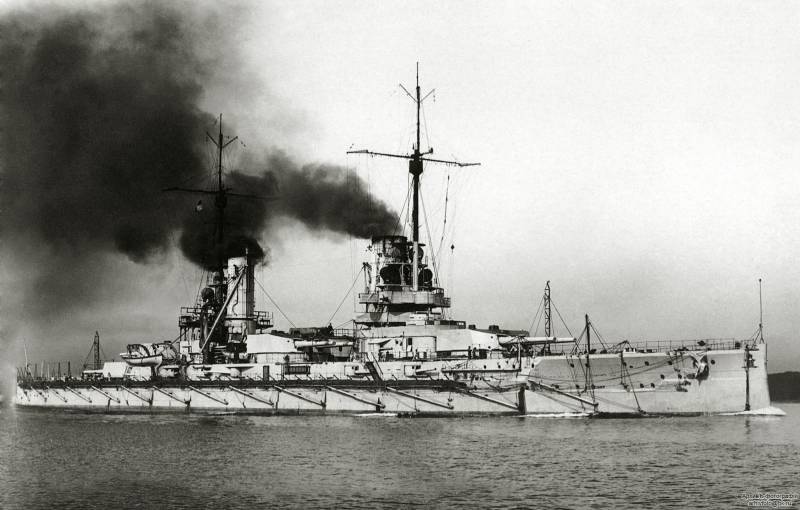

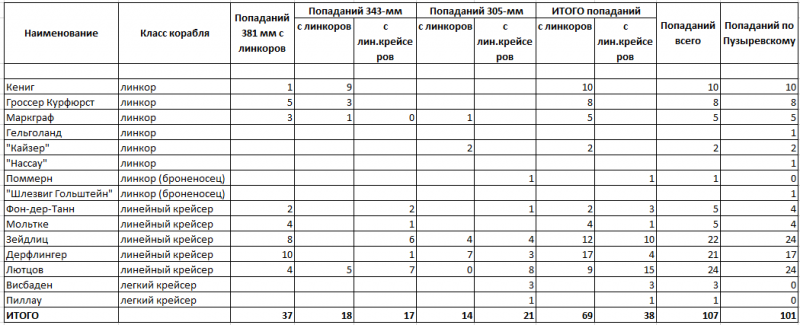
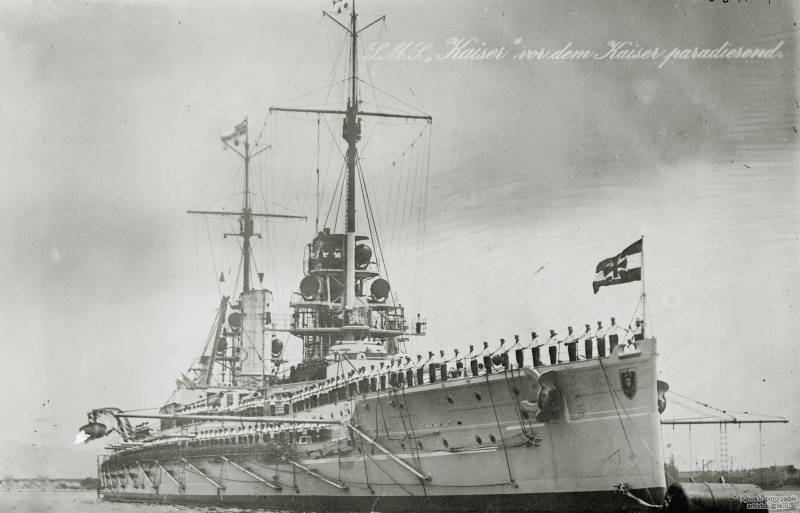
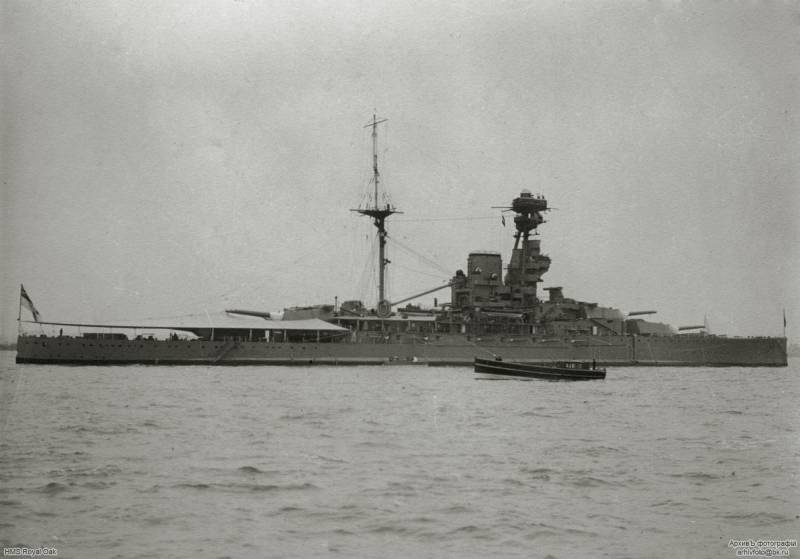
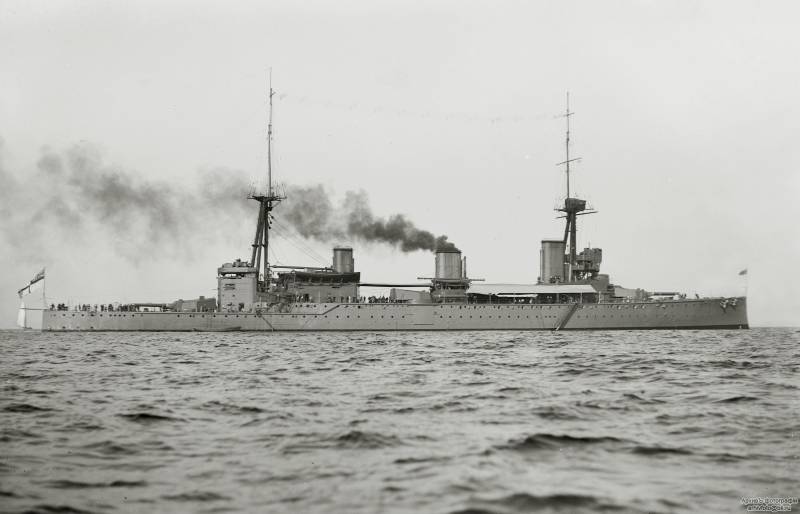
Information